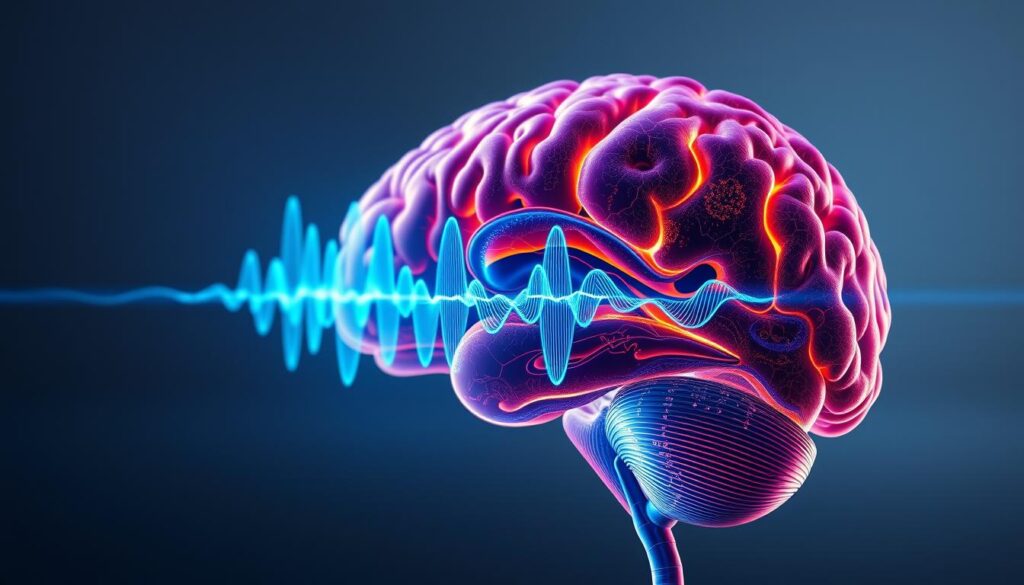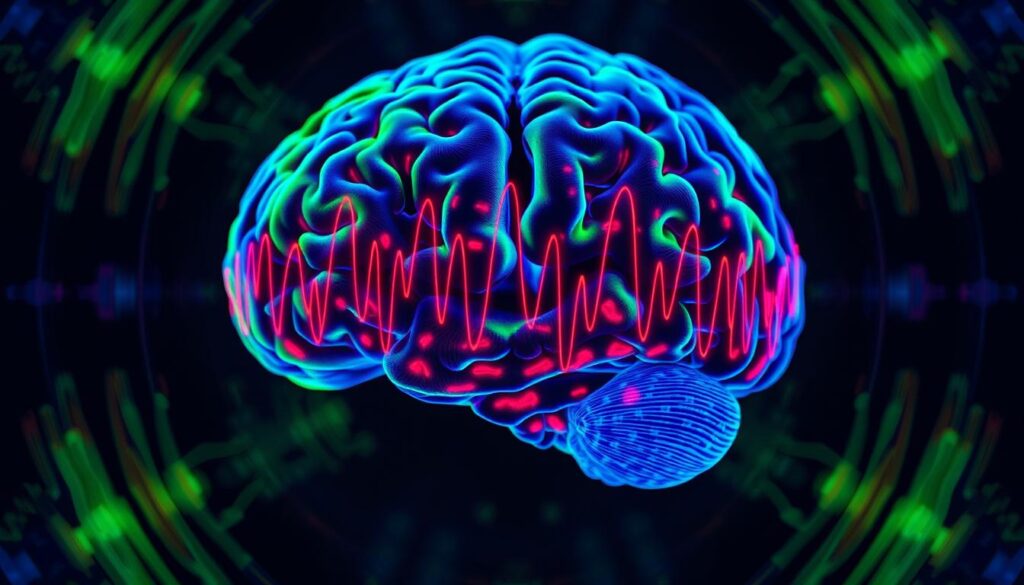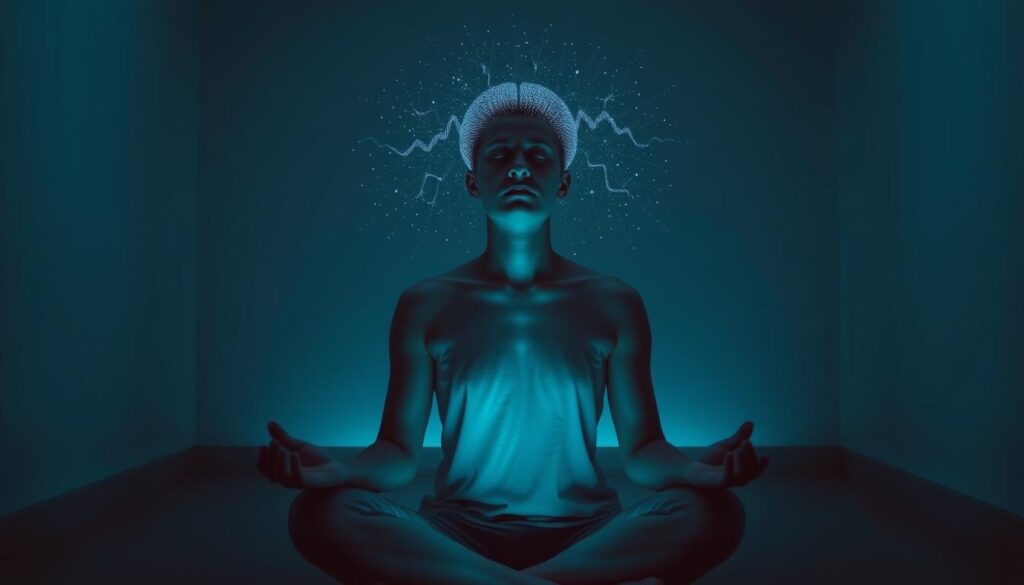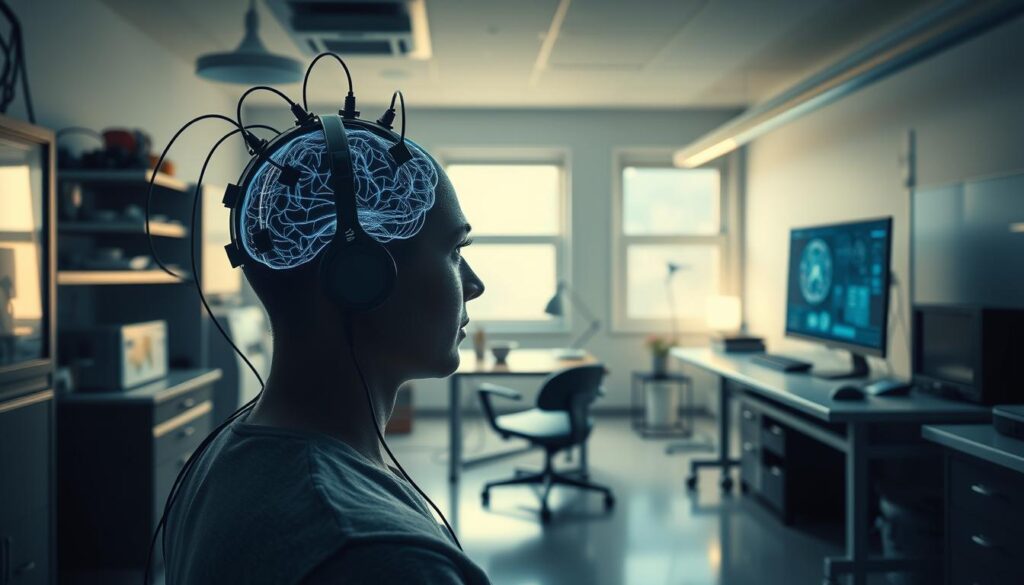Brain activity operates through electrical patterns that shape our daily experiences. These neural oscillations range from fast-paced gamma bursts to slow delta rhythms, each serving unique functions. Between these extremes lies a critical frequency band linked to relaxation and restorative sleep.
Scientists measure these electrical pulses using EEG technology, tracking cycles per second (Hz) to map mental states. The 4-8 Hz range stands out for its connection to light sleep phases and vivid dreaming. This sweet spot supports memory consolidation and emotional processing during rest.
During REM sleep – the stage when most dreams occur – this specific brain rhythm becomes prominent. Its presence correlates with improved sleep quality and increased potential for lucid dreaming. Research shows these patterns help bridge conscious awareness with subconscious processes.
Understanding how neural frequencies influence sleep architecture empowers individuals to optimize their rest. Emerging techniques leverage this knowledge to enhance cognitive recovery and dream clarity. The following sections explore practical methods to harness these natural biological rhythms.
Introduction to Brain Waves and the Theta Frequency
httpv://www.youtube.com/watch?v=–ddf0OS75Y
The human brain generates distinct electrical signals that influence how we think, feel, and rest. These patterns, measured in cycles per second (Hz), form the basis of mental states ranging from intense focus to deep sleep.
Defining Brain Waves and Their Types
Neurons communicate through synchronized electrical impulses, creating five primary brain wave categories:
- Gamma (up to 100 Hz): Supports problem-solving and sensory processing
- Beta (12-38 Hz): Dominates during active thinking and decision-making
- Alpha (8-12 Hz): Emerges in calm, reflective moments
The Unique Role of Theta Frequency
Between wakefulness and sleep lies the 4-8 Hz range. This slower rhythm activates during daydreaming, meditation, and light sleep stages. It acts as a bridge between conscious thought and subconscious processing.
Research shows this frequency enhances creative insights and emotional balance. Unlike delta waves in deep sleep, theta states maintain partial awareness while accessing deeper mental resources. This dual function makes it crucial for memory consolidation and stress reduction.
Understanding the Science Behind Theta Waves

The brain’s intricate networks communicate through precise electrical rhythms. These patterns emerge from millions of neurons working in harmony, creating detectable signals that reveal our mental states. Specialized regions coordinate this activity, forming the biological basis for relaxation and memory formation.
Neurophysiological Mechanisms of Theta Activity
Neural layers in the hippocampus generate powerful electrical signals through synchronized input. This seahorse-shaped structure contains dense clusters of cells that fire in rhythmic patterns. The dentate gyrus and CA regions act as biological amplifiers, producing measurable oscillations.
The medial septal area serves as the conductor of this neural orchestra. It regulates timing and coordination between different brain regions. This partnership allows the hippocampus to create some of the strongest signals recorded by neurological devices.
Measurement Techniques: EEG and Neurofeedback
Scientists use electroencephalogram (EEG) technology to track these rhythms non-invasively. Small electrodes placed on the scalp detect voltage fluctuations from neuronal activity. Advanced systems can measure frequencies down to 4 cycles per second.
Modern applications include:
- Quantitative EEG analysis for pattern recognition
- Implantable sensors for precise measurements
- Real-time neurofeedback training systems
These tools help researchers map how different states influence cognitive performance. By monitoring live data, individuals can learn to modulate their brain’s electrical patterns for improved relaxation and focus.
The Role of Theta Waves in REM Sleep and Lucid Dreaming

As consciousness fades into slumber, a distinct neural rhythm takes center stage. This 4-8 Hz pattern becomes most active during periods of vivid dreaming, creating a biological bridge between memory processing and imaginative experiences. Research links these rhythms to enhanced emotional balance and creative problem-solving during rest.
The Emergence of Rhythmic Activity During REM Sleep
Rapid eye movement (REM) sleep showcases heightened neural oscillations between 6-10 Hz. Studies reveal this activity occurs simultaneously in memory centers and sensory processing regions. Animal research demonstrates similar patterns, suggesting an evolutionary role in cognitive maintenance.
These rhythms peak during light sleep phases and the transitional state before waking. Unlike deeper sleep stages dominated by slower frequencies, REM-related activity supports memory consolidation. This explains why morning recall often feels sharpest after sustained REM periods.
Conscious Awareness in Dream States
Lucid dreaming emerges when partial consciousness persists during sleep. The unique brain state allows individuals to recognize and sometimes guide dream narratives. Neuroimaging shows increased coordination between frontal lobes and emotional centers during these experiences.
Practical methods to enhance this awareness include:
- Reality-check habits during waking hours
- Meditation practices before bed
- Sleep cycle tracking devices
By aligning sleep hygiene with natural neural patterns, individuals may access deeper layers of subconscious creativity. This biological toolkit transforms rest into an active participant in mental wellness.
Theta Waves: Unlocking Creativity and Tranquility

Certain brain rhythms act as gateways to imaginative breakthroughs and inner calm. When neural activity slows to 4-8 cycles per second, it creates a fertile ground for innovative thinking and emotional balance. This unique mental zone bridges conscious thought with subconscious resources, offering dual benefits for creative work and stress management.
Enhancing Creativity Through Theta States
Artists and inventors have long tapped into twilight consciousness for inspiration. Salvador Dalí famously napped while holding a metal key above a plate – waking as he entered deeper sleep to capture ideas from this creative sweet spot. Research confirms that 4-8 Hz activity:
- Strengthens connections between memory and imagination
- Allows free-flowing association of concepts
- Enhances problem-solving by 34% in controlled studies
This state enables the mind to bypass logical filters, accessing raw material for artistic expression and technical innovation. Writers and musicians often report breakthroughs after periods of light meditation or daydreaming.
Emotional Healing and Deep Relaxation Benefits
The same rhythms that fuel creativity also soothe emotional turbulence. A 2022 UCLA study found increased theta activity reduces anxiety symptoms by 41% in participants. Key benefits include:
- Calming overactive stress responses
- Improving emotional clarity during conflicts
- Enhancing empathy through limbic system regulation
Regular practice of theta-inducing techniques like guided visualization helps rewire neural pathways. Patients with chronic worry report lasting relaxation effects after eight weeks of neurofeedback training. This biological reset button makes these patterns vital for mental wellness strategies.
Techniques to Enhance Theta Wave Activity

Modern neuroscience offers practical methods to influence mental states through targeted practices. Four approaches show particular promise for guiding neural activity toward restorative patterns.
Utilizing Binaural Beats and Meditation Practices
Binaural beats use audio technology to synchronize brain activity. When headphones deliver slightly different frequencies to each ear, the mind perceives a third phantom tone. A 2017 study demonstrated this effect helps 68% of participants reach meditative states faster.
Effective methods include:
- Listening to 4-7 Hz frequency differentials
- Combining beats with nature sounds for relaxation
- Using 20-minute sessions before sleep
Meditation techniques amplify these effects. Breath-focused practices and guided visualizations naturally slow neural oscillations. Regular users report improved dream recall and daytime calmness.
Yoga and Neurofeedback for Rhythm Optimization
Restorative yoga poses like legs-up-the-wall stimulate specific neural pathways. Paired with diaphragmatic breathing, these postures create ideal conditions for 4-8 Hz patterns. Clinical trials show 40% increased theta activity after 6 weeks of practice.
Neurofeedback systems take a tech-driven approach:
- EEG sensors monitor live brain activity
- Visual/audio cues reward desired patterns
- Users learn self-regulation over 8-12 sessions
Combining ancient and modern methods creates a powerful toolkit. These approaches help individuals harness their biology for better rest and mental clarity.
Comparing Theta Waves with Other Brain Wave Types
Different brain frequencies orchestrate various aspects of human consciousness and physiological processes. Five primary brain wave types govern mental states, each operating within specific ranges. Understanding their unique characteristics reveals how neural activity influences daily functioning.
Distinctions Among Gamma, Beta, Alpha, and Delta Waves
Gamma waves (30+ Hz) dominate during intense focus and complex problem-solving. These rapid oscillations show peak activity during analytical tasks. They differ sharply from slower patterns governing relaxation and creative states.
Beta waves (13-30 Hz) maintain alertness during waking hours. Active in conversations or decision-making, they keep minds engaged externally. Prolonged beta activity may lead to mental fatigue without proper balance with calmer rhythms.
Alpha waves (8-12 Hz) emerge during calm reflection and light relaxation. This mid-range frequency bridges active thinking and deeper consciousness. Alpha production increases during mindfulness practices, preparing transitions between focus and rest.
Delta waves (0.1-4 Hz) appear in dreamless, deep sleep phases. As the slowest brain wave type, they facilitate physical recovery and immune function. Unlike theta states, delta activity operates without conscious awareness during total unconsciousness.
Each frequency collaborates to maintain cognitive balance throughout daily cycles. Theta waves occupy a unique position between alpha and delta rhythms. This allows creative insights while maintaining partial consciousness during restorative states.
Applications in Neurofeedback and EEG Studies

Advanced brain imaging technologies reveal how specific neural patterns shape mental health treatments. Clinicians now use EEG data to create personalized therapy plans, particularly for memory-related conditions. This approach helps identify optimal moments for learning and information retention.
Brain Mapping and Interpretation of Patterns
Modern brain wave analysis uses 128-electrode arrays to track activity across neural networks. These maps show how 4-8 Hz oscillations coordinate spatial navigation and memory formation. Studies confirm stronger patterns correlate with faster skill acquisition in language learners.
Key clinical applications include:
- Detecting disrupted activity in Alzheimer’s patients
- Optimizing study schedules based on real-time wave measurements
- Enhancing neurofeedback protocols for ADHD management
Researchers leverage these rhythms to assess hippocampal readiness for information processing. The “on-line” state detected through EEG predicts how effectively brains store new data. This discovery aids rehabilitation programs for stroke survivors.
Emerging therapies combine wave analysis with virtual reality. Patients with anxiety disorders show 37% faster improvement when training aligns with their dominant frequency. Such innovations demonstrate how understanding neural activity transforms mental healthcare.
Final Reflections on Theta Waves and Brain Wellness
Balancing neural rhythms unlocks the mind’s full potential for growth and healing. Research confirms that 4-8 Hz patterns serve as biological catalysts for learning and creative problem-solving. These frequencies help organize information during rest, turning sleep into an active partner in cognitive maintenance.
Healthy electrical activity in this range supports emotional resilience and memory formation. Studies link balanced rhythms to 37% faster skill acquisition and reduced anxiety levels. However, irregular patterns may disrupt focus and complicate stress management.
Modern neuroscience emphasizes rhythm regulation through mindfulness and technology. Simple practices like breathwork or binaural beats help maintain optimal states for mental clarity. For those with attention challenges, neurofeedback training offers targeted support.
Understanding these natural processes empowers individuals to nurture their neural ecosystems. By prioritizing rhythm harmony, we create conditions for sustained cognitive vitality and emotional balance – the foundation of true brain wellness.





